Jun 4 2021
The comprehensive discussion at the forthcoming Conference of the Parties (COP26) in November will probably focus on how the world has deviated from the track to fulfill the Paris Agreement’s goals of ending global warming at much below 2°C.
 There are encouraging signs in emerging clean energy technology 'niches'—countries, states, or corporations—that are pioneering decarbonization. Image Credit: Petmal/iStock.
There are encouraging signs in emerging clean energy technology 'niches'—countries, states, or corporations—that are pioneering decarbonization. Image Credit: Petmal/iStock.
But according to an article from the University of California San Diego (UC San Diego) and published in the Nature Energy journal, world diplomats will find encouraging signs in rising clean energy technology 'niches'—nations, corporations, or states—that are pioneering decarbonization.
“In certain areas, adoption rates for solar and wind turbines, as well as electric vehicles are very high and increasing every year,” wrote the authors of the opinion piece Ryan Hanna, an assistant research scientist from UC San Diego’s Center for Energy Research and David G. Victor, professor of industrial innovation from UC San Diego’s School of Global Policy and Strategy.
It’s important to look to niches because this is where the real leg work of decarbonization is happening. In fact, one can think about the entire challenge of decarbonizing as one of opening and growing niches—for new technologies, policies and practices, which are all needed to address the climate crisis.
Study Researchers
But the glimmer of hope for decarbonization will be crucial for diplomats at COP26, who may be prepared for disappointment as they initiate an official 'stocktaking' process of assessing previous emissions. In 2021, every nation will report on emissions accounting for the past five years and declare new, bolder pledges to reduce greenhouse gasses.
Before the COVID-19 pandemic, global fossil fuel emissions had been increasing at around 1% per year over the last 10 years. During that same period, fossil fuel emissions in the U.S. dropped by around 1% per year; but that slight dip is nowhere close to the reduction mentioned in the U.S.’s actual pledge to the Paris Agreement.
“The abundant talk in recent years about ‘the energy transition’ has barely nudged dependence on conventional fossil fuels, nor has it much altered the trajectory of CO2 emissions or put the world on track to meet Paris goals. Instead, policymakers should measure the real engine rooms of technological change—to niche markets,” wrote Hanna and Victor.
The researchers pointed to an increasing number of markets in which clean technology is being rolled out at rates that are much higher than regional and global averages.
“Norway and California are leading on electric vehicles, Ireland on wind power and China on electric buses and new nuclear,” wrote Hanna and Victor.
The present-generation of pioneers in energy are those who are truly doing the hard work of producing low-carbon technologies and making these technologies available to the world.
Such leaders that develop and trial new technologies are generally small groups. But they are still crucial to the climate change crises because they take on risk and disclose what is possible, thus reducing the risk for worldwide markets to follow.
For instance, starting in 2010, Germany introduced a huge investment in solar photovoltaics, which cut down costs, rendering photovoltaics more economically and politically viable throughout the world. Hanna and Victor give credit to Germany’s leadership for the extensive photovoltaic market available to the world today.
Yet, preventing at least one-third of global emissions will need technologies that are currently prototypes. To obtain more clean energy technologies installed on a global scale, new investments had to be made in research and development (R&D), chiefly in innovative technologies associated with electric power grids.
Such investments are mixed in Europe, strong in China, and are lagging along with other R&D expenditures in the United States.
In the U.S., a new administration serious about climate change may allow for renewed pulses of spending on R&D–for example, through a prospective infrastructure bill that could gain legislative approval this autumn–as innovation is one of the few areas of energy policy bipartisan consensus.
Study Researchers
There is an urgent need, as reducing warming to 1.5°C as per the Paris Agreement, has become more and more out of reach. At present, meeting the goal needs a constant decrease in emissions of around 6% per year throughout the entire globe.
“That is a speed and scope on par with what was delivered by global pandemic lockdowns, but previously unprecedented in history and far outside the realm of what’s practical,” concluded the authors.
The researchers concluded that COP26, if handled by diplomats thinking like revolutionaries and not like a diplomatic committee, is a chance to take stock of the agricultural and industrial revolutions that will be required for decarbonization.
Journal Reference:
Hanna, R & Victor, D G (2021) Marking the decarbonization revolutions. Nature Energy. doi.org/10.1038/s41560-021-00854-1.